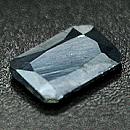|
|
||||||||||||||||
|
||||||||||||||||
|
||||||
|
|
|
|
Digenite
|
|
| | |
| Discovered in 1844; IMA status: Valid (pre-IMA; Grandfathered) | ||
|
| ||
|
Chemistry |
|
|
| |
|
Cu9S5 | |
|
|
Copper Sulfide |
|
Molecular Weight: |
732.24 gm |
|
Composition: |
Copper |
78.10 % |
Cu |
|
|
|
|
Sulfur |
21.90 % |
S |
|
|
|
|
|
100.00 % |
|
|
|
|
|
|
||||
|
Classification |
|
|
| |
|
Sulfides | |
|
2/B.01-30 | |
|
|
2 : SULFIDES and SULFOSALTS (sulfides, selenides,
tellurides; arsenides, antimonides, bismuthides; sulfarsenites,
sulfantimonites, sulfbismuthites, etc.) |
|
Related to: |
Chalcocite-Digenite Group. Digenite-Berzelianite Series. |
|
Varieties: |
None |
|
Synonyms: |
α-Chalcocite, Blue Chalcocite, Carmenite, Isometric Chalcocite, Kupferglanz-α, Neodigenite |
|
|
|
|
Crystal Data |
|
|
|
|
|
Rarely in pseudocubic crystals, to 3 cm; more commonly as intergrowths with other copper sulfides. |
|
|
None |
|
|
|
|
|
Physical Properties |
|
|
|
|
|
Distinct/Good on {111} (on synthetic material) |
|
|
Conchoidal |
|
|
Brittle |
|
|
2.5 - 3.0 |
|
|
5.546 (g/cm3) |
|
|
None |
|
|
Not Radioactive |
|
|
|
|
|
Optical Properties |
|
|
|
|
|
Blue to Black; distinctly Blue in polished section. |
|
|
Opaque |
|
|
Metallic |
|
|
R: (400) 29.6, (420) 28.8, (440) 28.0, (460) 27.0, (480) 25.9, (500) 24.8, (520) 23.5, (540) 22.2, (560) 21.0, (580) 19.9, (600) 18.9, (620) 18.0, (640) 17.2, (660) 16.3, (680) 15.5, (700) 14.8 |
|
|
0.000 (mostly Isotropic) |
|
|
None |
|
|
Mostly Isotropic. Color in reflected light: Blue |
|
|
|
|
|
Occurances |
|
|
|
|
|
Geological Setting: |
In hydrothermal copper deposits of primary and secondary origin. Formed under a wide range of conditions; reported from mafic intrusives, as a volcanic exhalation product, and in pegmatites. |
|
Common Associations: |
Chalcocite, Djurleite, Bornite, Chalcopyrite, other copper minerals, Pyrite. |
|
Common Impurities: |
Fe |
|
Type Locality: |
Copper slate deposits, Sangerhausen, Saxony-Anhalt, Germany |
|
Year Discovered: |
1844 |
|
View mineral photos: | |
|
|
|
|
More Information |
|
|
|
|
|
| |
|
|
|
|
Digenite is named from the Greek word "digenus" meaning "of two origins" or "sexes", because of it's relationship to Chalcocite and Covellite due to the presumed presence of both cuprous and cupric ions. Digenite is found in copper sulfide deposits and is typically associated with and often intergrown with Chalcocite, Covellite, Djurleite, Bornite, Chalcopyrite and Pyrite. The type locality is Sangerhausen, Thuringia, Germany, in copper slate deposits. Digenite
is found at only a handful of localities worldwide.
From Sangerhausen, Thuringia, Germany [TL]. In the Botallack
mine, St. Just, Cornwall, and from Seathwaite Tarn,
near Coniston, Cumbria, England. At Listulli, Norway.
From Kiruna, Sweden. In the USA, crystallized at Butte,
Silver Bow County, Montana; in Arizona, from the United
Verde mine, Jerome, Yavapai County, the Magma mine,
Superior, Pinal County, and at Bisbee, Cochise County.
Abundant at Kennicott, Alaska. From Cananea, Sonora,
Mexico. In Namibia, at Tsumeb. At Dongxiang, Jiangxi
Province, China. Probably not yet recognized at many
other localities. |
|
|
We
have not photographed our Digenite gems. Please
check back soon. |
